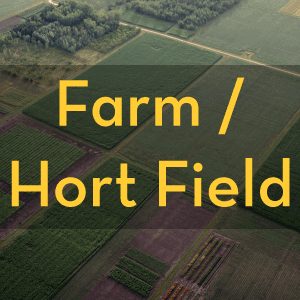Crop History (1)
This information is essential for us to provide the most accurate nitrogen recommendations. Indicate crops grown the past two most recent growing seasons. BE SURE TO USE THE CROP CODE NUMBER FROM THE LIST ON BOTTOM OF THE SHEET. If alfalfa was the crop grown during either or both of the two previous growing seasons, it is important to indicate the number of plants (crowns) per square foot.
Proposed Crops and Yield Goals (2)
You can select recommendations for up to three crops by entering the corresponding crop code number, or three yield goals for one crop. At least one option must be completed to receive a fertilizer recommendation, but there is no requirement to complete all options. If alfalfa is planned for the second crop year, list the crop code 01 under Option 2 or Option 3 with the desired yield in order to get a lime recommendation to pH 6.5. For CRP acres, list the crop most similar to that being seeded (e.g. 04 for legume/grass hay, or 22 for native grasses).
Test Requested (3)
Indicate the tests requested for each sample. Before selecting nitrate, read the information given below (under ‘Nitrate Test’) to see if it applies to your area or crop. The cost for each test is shown on the Sheet.
- Regular Series: Includes phosphorus, potassium, pH and lime requirement, percent organic matter and texture. Sample the plow layer for cultivated land, or to three inches for permanent pastures or sod fields.
- Special Test: Includes sulfur, zinc, copper, iron, manganese, boron, calcium, magnesium, % organic matter, soluble salts (electrical conductivity). Copper recommendations apply only for peat or muck soils. Research has shown that for Minnesota soils, tests for iron and manganese are not practical; they are included to accommodate special requests. These tests are to be determined only on the plow layer sample.
- Nitrate Test: This test requires soil be collected to a depth of 24 inches. There are two options. One is to submit two samples, 0-6 inch and 6-24 inch depths. The second is to collect the soil from 0-24 inches. The test applies to non-sandy soils in western Minnesota with an exception noted below. This test is preferred for making nitrogen recommendations for the counties west of and including Lake of the Woods, Beltrami, Becker, Otter Tail, Douglas, Pope, Kandiyohi, Renville, Redwood, Cottonwood, and Jackson counties. In these counties, the test is used in making nitrogen recommendations for corn, small grains, potatoes and sugar beets.
If you’re in western Minnesota and you want the regular series test or any of the other special tests in addition to the nitrate test, take samples from 0-6 and 0-24 inches and enter on separate lines on the sheet.
For the counties east of those cited above, the soil nitrate test is used only if the sample is collected in the spring before or near planting (April 1 – June 15). Nitrogen fertilizer recommendations will not be based on the analysis of only plow layer samples for nitrate-nitrogen. If only a plow layer sample is submitted, nitrogen recommendations will be based on cropping history, intended crop, yield goal, and soil organic matter level.
Samples collected for the nitrate test must be air-dried immediately to slow down microbial activity and sent to the Lab within 24 hours. Drying can be accomplished by spreading the soil in the sun, or placing near a heat source. If only nitrate is to be determined, the samples can be dried in a microwave oven using several 2 minute power cycles, stirring between each cycle. Alternatively, samples can be frozen and sent to the Lab in a well insulated package.
